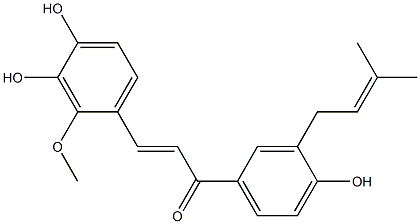All AbMole products are for research use only, cannot be used for human consumption.

Licochalcone D is a potent inhibitor of NF-kappaB (NF-κB) p65 with antioxidant, anti-inflammatory, anti-cancer properties. Licochalcone D is a flavonoid compound mainly existing in the root of Glycyrrhiza inflate.
| Molecular Weight | 354.40 |
| Formula | C21H22O5 |
| CAS Number | 144506-15-0 |
| Solubility (25°C) | DMSO ≥ 10 mg/mL |
| Storage | 2-8°C, protect from light, dry, sealed |
| Related NF-κB Products |
|---|
| Safranal
Safranal is an orally active component of Saffron (Crocus sativus). Safranal has neuroprotective and anti-inflammatory effects and it can be used for the resaerch of Parkinson’s disease. |
| DCZ5418
DCZ5418 is an inhibitor of TRIP13. |
| Ro 106-9920
Ro 106-9920 is a potent inhibitor of NF-kappaB. |
| MRS2693 trisodium
MRS2693 trisodium is a selective P2Y6 agonist with an EC50 value of 0.015 μM. |
| PTD-p65-P1 Peptide TFA
PTD-p65-P1 Peptide TFA is a potent, selective nuclear transcription factor NF-κB inhibitor and derives from the p65 subunit of NF-κB amino acid residues 271-282, which selectively inhibits NF-κB activation induced by various inflammatory stimulation, down-regulate NF-κB-mediated gene expression and up-regulate apoptosis. |
All AbMole products are for research use only, cannot be used for human consumption or veterinary use. We do not provide products or services to individuals. Please comply with the intended use and do not use AbMole products for any other purpose.


Products are for research use only. Not for human use. We do not sell to patients.
© Copyright 2010-2024 AbMole BioScience. All Rights Reserved.
